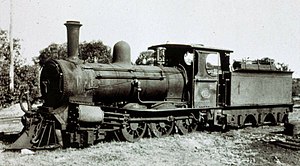The WAGR A class was a class of 2-6-0 steam locomotives designed by Beyer, Peacock & Co and operated by the Western Australian Government Railways (WAGR) between 1881 and 1955.
| WAGR A class | |||||||||||||||||||||
|---|---|---|---|---|---|---|---|---|---|---|---|---|---|---|---|---|---|---|---|---|---|
 A11 at Midland Junction in 1943 | |||||||||||||||||||||
| |||||||||||||||||||||
| |||||||||||||||||||||
| |||||||||||||||||||||
| |||||||||||||||||||||
History
editJohn Robb, a contractor who was constructing the first section of the Eastern Railway between Fremantle and Guildford, ordered what would become the first member of the A class from Beyer, Peacock & Co. in Manchester.[1] The locomotive was arrived in Western Australia in 1880, and was similar in design to the South Australian Railways W class.[2]
Upon completion of the project in 1881, the WAGR acquired this locomotive and numbered it 3. The locomotive proved well suited to passenger and mixed train duties of the day; the type eventually grew to 13 examples via repeat orders from Beyer Peacock & Co. plus one example supplied by Dübs & Co. Three of the locomotives had six-wheel tenders instead of four-wheel ones. In 1885, when engine class designations were introduced, the locomotives became known as the A class.[1][3]
Initially, the A class was used for main-line passenger services and later on branch lines when they were superseded by the larger G class. Several were used in various railway construction contracts, and many were sold to the timber industry as they became surplus to WAGR requirements. Others were relegated to shunting duties at the end of their working lives. The last example was withdrawn from service in 1955.[4][5]
Two examples of the A class have been preserved. A11 was initially placed on display at the Perth Zoo and is now with the Western Australian Rail Transport Museum, while A15 was plinthed in Bunbury and is currently undergoing restoration in Meredith, Victoria.[2][5][6]
Namesake
editThe A class designation was reused in the 1960s when the A class diesel locomotives entered service.
See also
editReferences
editNotes
edit- ^ a b Gunzburg 1984, p. 19.
- ^ a b Whiteford, David; De Bruin, Charles; Watson, Lindsay; Watson, Neville (1983). Western Australian Preserved Locomotives. Elizabeth: Railmac Publications. p. 11. ISBN 0-949817-19-8.
- ^ Minchin, RS; Higham, GJ (1981). Robb's Railway Fremantle to Guildford Railway Centenary. Bassendean: Australian Railway Historical Society. p. 10. ISBN 0-9599690-2-0.
- ^ Gunzburg 1984, pp. 19 and 21.
- ^ a b A11 Australian Steam
- ^ A15 Australian Steam
Cited works
edit- Gunzburg, Adrian (1984). A History of WAGR Steam Locomotives. Perth: Australian Railway Historical Society (Western Australian Division). ISBN 0959969039.
External links
editMedia related to WAGR A class at Wikimedia Commons